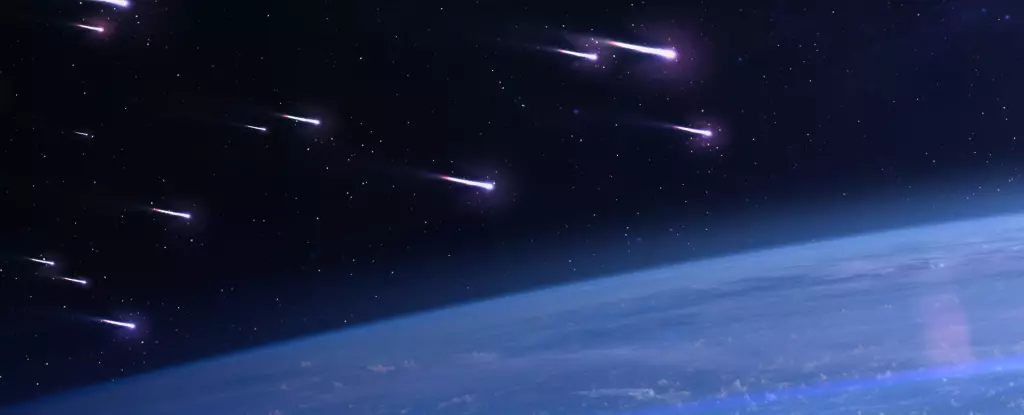The Leonid meteor shower, often celebrated for its dramatic displays, continues to captivate amateur and professional astronomers alike. While many may regard meteor showers as fleeting moments in the vast expanse of space, the Leonids stand out due to their historical significance and occasional explosive outbursts. Having experienced a firsthand sighting during November 1998, my memories of watching the ethereal streaks light up the Kuwaiti night sky remain vivid, accentuating the unique and exhilarating nature of these celestial events.
Every 33 years, the Leonids showcase their brilliance as the Earth traverses a debris cloud left by the periodic comet 55P/Tempel-Tuttle. During these peak periods, meteors plummet through the atmosphere like miniature fireworks, illuminating the night sky with an intensity that eclipses the mundane. Although the next significant outburst won’t be until the 2030s, this year’s Leonid shower promises exciting possibilities, making it a focal point for stargazers eager for a celestial spectacle.
This year, while the zealous predictions of past astonishing displays may evoke nostalgia, the meteor shower is slated to follow a more subdued path. The annual maximum is anticipated to occur on November 17 at approximately 4:00 Universal Time (UT). Under ideal conditions—free from the interference of light pollution—the hourly rate of falling meteors is predicted to hover around 15 to 20. This modest estimate means that for stargazers in certain regions, notably Europe, early dawn hours present the best opportunity to witness the shower’s peak.
Yet, there is more to explore this November than just the established Leonids. Notably, Jérémy Vaubaillon from the Paris Observatory has highlighted the potential significance of three older streams associated with the Leonid meteors, which could enhance the viewing experience. The Earth’s proximity to these trails—including those laid down in 1633 and 1733—hints at the possibility of unexpected meteor activity. Each encounter with these streams poses a tantalizing question: could 2024 deliver a surprising burst of shooting stars, despite predictions suggesting otherwise?
As twilight approaches and the moon transitions toward a gibbous phase prior to full illumination, it will cast a growing glow over the night sky. This increase in natural light poses a challenge for astronomers, as moonlit skies tend to diminish visibility, thereby reducing the overall meteor count observable from Earth. While it’s essential to acknowledge this drawback, it is equally vital not to be discouraged. Even in less-than-ideal conditions, dedicated skywatchers may still catch glimpses of meteors streaking across the vast darkness.
Moreover, strategizing viewing locations plays a critical role in optimizing the experience. Heading away from urban environments that emit excessive light pollution to a well-planned spot can make a marked difference. It allows one to maximize the meteor peak’s potential, enhancing the likelihood of witnessing the Leonids in all their luminous glory.
For those keen on documenting this year’s meteor shower, utilizing technology can be invaluable. Setting up a digital camera with a wide-angle lens can help capture the full expanse of the sky, enhancing the chances of photographing meteors. Automated devices such as intervalometers allow users to focus on enjoyment rather than the technical burdens of capturing the event. While savoring a warm beverage can amplify the comfort of those cool November mornings, capturing the beauty of the cosmos immortalizes these precious moments.
It’s essential to establish realistic expectations; even with ideal equipment and conditions, the unpredictable nature of meteor showers can yield varied results. Although the real draw may not be the numerical count of visible meteors, but rather the serene experience of connecting with the universe, lying back to watch nature’s fireworks is a compelling pastime that unites people with a sense of wonder.
As we look ahead, while 2024 may not be a year of significant activity for the Leonids, it beckons the question of what the future holds. With promises of more vibrant displays in the 2030s, this year serves as a reminder of the anticipation that surrounds celestial events. The excitement of potentially witnessing a meteor storm or burst’s return keeps many enthusiasts engaged, fueling the fascination with the night sky. Meteor season is always worth celebrating, and every stargazer knows that in the vast, unpredictable expanses of the cosmos, surprises await those who are willing to look up.


Leave a Reply